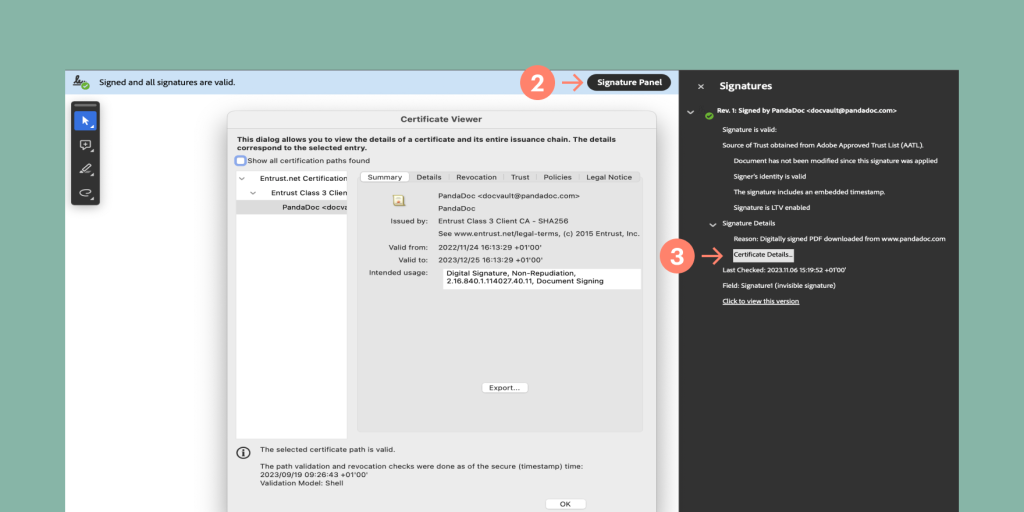In the ever-evolving digital landscape, ensuring legal compliance in online transactions is of paramount importance.
A significant aspect of this is digital signatures, a concept embraced by businesses worldwide for its convenience, efficiency, and security.
In this context, PandaDoc eSignatures have emerged as a reliable solution, seamlessly complying with key legislation such as the United States Electronic Signatures in Global and National Commerce (ESIGN) Act and the Uniform Electronic Transactions Act (UETA).
This article delves into the intricacies of these legal frameworks and unravels how PandaDoc aligns with these laws to provide a safe and compliant eSignature solution.
Understanding UETA and the ESIGN Act
UETA
The Uniform Electronic Transactions Act (UETA) is a law that establishes the legal framework for electronic transactions, including electronic signatures and records.
Here’s an explanation of UETA and its significance:
Key principles and objectives of UETA:
- Legal Equivalence: UETA establishes that electronic records and signatures should be given the same legal weight and effect as paper writings and signatures.
- Consent: UETA requires the consent of the parties involved in an electronic transaction to conduct business electronically.
- Record Retention: UETA ensures that electronic records are retained and preserved if required by law.
- Integrity and Accuracy: UETA emphasizes the importance of maintaining the integrity and accuracy of electronic records and signatures.
- Interoperability: UETA aims to promote interoperability between different electronic systems used in transactions.
UETA’s impact on electronic signatures and records:
- Validity and Enforceability: UETA validates the use of electronic signatures as legally binding and enforceable, provided they meet certain requirements such as intent to sign and association with the signer.
- Writing Requirement: UETA recognizes that an electronic record satisfies any legal requirement for a written document.
- Business Transactions: UETA enables businesses to conduct a wide range of transactions electronically, including contracts, agreements, and other legal documents.
- Consumer Protection: UETA includes provisions to protect consumers in electronic transactions, such as providing information in a clear and conspicuous manner.
Overall, UETA provides a legal foundation for the use of electronic transactions, ensuring that electronic signatures and records have the same validity and enforceability as traditional paper-based transactions.
Its principles and objectives facilitate the growth of electronic commerce and streamline business processes in the digital age.
ESIGN Act
The ESIGN Act, enacted by the United States Congress in 2000, is a federal law that facilitates the use of electronic signatures and records in interstate and foreign commerce.
Its primary objective is to remove barriers to electronic transactions, promote efficiency, and ensure the validity and enforceability of electronic contracts.
With the rapid growth of e-commerce and digital transactions, there was a need for a legal framework that would provide certainty and confidence in conducting business electronically.
The ESIGN Act was passed to address this need, fostering trust in electronic transactions while ensuring consumer protection.
Core provisions and requirements of the ESIGN Act.
Validity of electronic records and signatures
The ESIGN Act establishes that electronic records and signatures have the same legal validity as traditional paper-based documents.
It ensures that electronic contracts and agreements are enforceable, given they meet certain requirements.
Consent
The Act requires the parties involved to demonstrate their consent to conduct a transaction electronically.
This consent can be expressed in various ways, including through explicit agreement or by engaging in the electronic transaction.
Consumer disclosures
The ESIGN Act sets guidelines for providing information or disclosures to consumers in electronic form.
It requires that these disclosures be provided in a manner that ensures consumers can access and retain them effectively.
Retention of records
The Act addresses the retention of electronic records, stating that parties must retain records in a manner that enables accurate reproductions and access to those records throughout the required retention period.
Consumer protection
The ESIGN Act includes provisions to protect consumers engaged in electronic transactions.
It ensures that consumers have the ability to withdraw consent, receive disclosures in a format they can retain, and are not forced to use electronic records or signatures against their will.
The ESIGN Act aims to promote the use of electronic signatures and records, providing a legal framework that allows businesses and individuals to conduct transactions with confidence and efficiency.
By embracing electronic commerce, the Act helps foster innovation and growth in the digital economy.
PandaDoc eSignatures: compliance features
PandaDoc’s eSignature platform is a comprehensive and legally-binding electronic signature solution.
The platform ensures compliance with ESIGN (Electronic Signatures in Global and National Commerce Act) and UETA (Uniform Electronic Transactions Act) regulations, providing users with confidence in the validity of their electronic signatures.
PandaDoc offers features such as electronic certificates with every signed document, in-person signing for mobile devices, and the ability to sign documents using various methods like typing, drawing, or uploading a handwritten signature.
It is an all-in-one digital signature software solution that enables users to create, manage, and eSign documents seamlessly, making it a valuable tool for businesses and individuals seeking a faster and more efficient way to streamline their document signing process.
PandaDoc’s compliance with the Uniform Electronic Transactions Act (UETA) ensures that it meets various requirements to ensure the validity and enforceability of electronic signatures.
Here are some key aspects of PandaDoc’s UETA compliance:
- Consent to electronic signatures: PandaDoc’s platform provides a clear and easily understandable process for obtaining consent to use electronic signatures. Users can explicitly indicate their agreement to conduct transactions electronically, ensuring compliance with UETA’s consent requirements.
- Record retention and retrieval: PandaDoc’s software enables users to securely store and retrieve electronic records, maintaining compliance with UETA’s record retention provisions. This ensures that electronic documents can be stored and accessed over an extended period, as required by law.
- Assurance of document integrity: PandaDoc implements measures to ensure the integrity of electronic documents. This includes safeguards to prevent unauthorized alterations or tampering of signed documents, providing assurance that the content remains unchanged after signing.
- Non-discrimination: UETA prohibits discrimination against electronic signatures and records solely based on their electronic form. PandaDoc’s platform treats electronic signatures and records with the same level of validity and enforceability as traditional paper-based documents, ensuring non-discrimination in the use of these digital transactions.
By adhering to UETA’s requirements, PandaDoc provides a legally binding and compliant electronic signature solution, instilling confidence in the validity and enforceability of electronic transactions.
PandaDoc’s eSignatures align with the Electronic Signatures in Global and National Commerce Act (ESIGN Act) by meeting various requirements established by the legislation.
Here are some key aspects of how PandaDoc’s eSignatures align with the ESIGN Act:
- Consent requirements under the ESIGN Act: PandaDoc provides a clear and easily understandable process for obtaining consent to use electronic signatures, ensuring compliance with the ESIGN Act’s consent provisions. Users can explicitly indicate their agreement to conduct transactions electronically, meeting the requirements for electronic consent.
- Mechanisms for attribution and intent: PandaDoc’s eSignature platform includes mechanisms for attributing electronic signatures to specific individuals and capturing their intent to sign a document. This ensures compliance with the ESIGN Act’s provisions regarding the identification of signers and their intent to be bound by the signed document.
- Ensuring security and authentication: PandaDoc implements robust security measures to protect the integrity and authenticity of electronic signatures. By utilizing encryption, audit trails, and user authentication mechanisms, PandaDoc ensures that electronic signatures are secure and meet the ESIGN Act’s requirements for tamper-evident signatures.
- Demonstrating “electronic agent” provisions: The ESIGN Act allows parties to use electronic agents to facilitate electronic transactions. PandaDoc’s platform enables users to designate representatives or agents to act on their behalf in the signing process, thus adhering to the “electronic agent” provisions outlined in the ESIGN Act.
By aligning with the ESIGN Act, PandaDoc’s eSignature platform provides users with a legally compliant and reliable solution for conducting electronic transactions with confidence.
Steps to ensure compliance using PandaDoc
To create an eSignature document in PandaDoc, follow these steps: open the PDF document or form, click on the “Sign” icon in the toolbar, select “Fill & Sign” from the right pane, and begin the process.
Fill in the required fields, add your signature, and review the document for accuracy.
Save and send it for signature. PandaDoc’s software makes creating eSignature documents seamless.
Specific features in PandaDoc that facilitate UETA and ESIGN Act compliance include:
- User authentication and identity verification: PandaDoc offers robust user authentication methods, such as email verification, two-factor authentication (2FA), and password protection, ensuring that only authorized individuals can access and sign documents. This feature helps meet the requirements of UETA and the ESIGN Act for verifying the identity of signers.
- Tamper-proof document storage and audit trail: PandaDoc provides secure document storage, protecting the integrity of electronic records. It also maintains a detailed audit trail that captures every action taken on a document, including when it was sent, viewed, signed, or modified. This tamper-proof storage and audit trail functionality fulfills UETA and ESIGN Act obligations for record retention and retrieval.
- Time-stamped electronic signatures: PandaDoc timestamps electronic signatures, providing an accurate record of when the signature was executed. This feature ensures compliance with UETA and the ESIGN Act’s requirement for evidence of the time of signing, helping to establish the chronological order of events in electronic transactions.
- Opt-out and withdrawal mechanisms: PandaDoc allows signers to opt-out of electronic transactions or withdraw their consent to conduct business electronically. By providing these mechanisms, PandaDoc adheres to UETA and the ESIGN Act’s provisions that grant signers the right to withdraw from electronic transactions if they choose to do so.
By incorporating these specific features, PandaDoc enhances compliance with UETA and the ESIGN Act, providing users with a secure and legally compliant platform for electronic signatures and transactions.
Benefits and limitations
Advantages of using PandaDoc eSignatures for UETA and ESIGN Act compliance
PandaDoc eSignatures offer a host of benefits for businesses seeking compliance with UETA and the ESIGN Act.
Firstly, the platform’s robust security features ensure that electronic records and signatures are as legally binding as their traditional counterparts.
Secondly, PandaDoc enhances efficiency by expediting and simplifying the signing process, eliminating the need for physical presence.
Moreover, the platform’s user-friendly interface and comprehensive audit trails facilitate transparency and accountability, essential elements in any legally compliant transaction.
However, it’s important to keep in mind that while PandaDoc supports compliance, ultimate responsibility for adherence to laws like the UETA and ESIGN Act lies with the businesses themselves.
PandaDoc eSignatures should, therefore, be a part of a broader compliance strategy that takes into account the specifics of a business’s legal and operational requirements.
Entrust Digital Signing Certificates for document security
PandaDoc emphasizes document security by relying on Entrust, a certified digital security solutions provider.
The platform generates identity-verified and secure digital signatures on electronic documents using Entrust’s trusted certificates. These certificates guarantee the validity and reliability of signed documents.
When using PandaDoc for document management, you can trust the security of your digital signatures. With Entrust as the underlying framework, your documents are safeguarded against tampering and forgery.
This partnership establishes a solid foundation for document security, offering the peace of mind required when working with digital documents.
How to find the Entrust trust anchor certificate on a signed document?
- Open the document with a PDF reader
- Click “Signature Panel”
- Click “Certificate Details”

Potential drawbacks of using PandaDoc for compliance purposes
While PandaDoc offers numerous advantages for UETA and ESIGN Act compliance, there could be potential drawbacks based on the unique circumstances of different businesses.
First, businesses operating in jurisdictions with specific electronic signature laws may need to check if PandaDoc aligns with those local regulations.
Second, not all document types may be suitable for electronic signatures, and businesses would need to identify which documents they can digitally sign and which ones they cannot.
Third, while PandaDoc provides robust security features, the risk of cyber threats cannot be eliminated completely, and businesses must have additional security measures in place.
Lastly, businesses will need to ensure that their users are comfortable with the digital signing process, as a lack of technical proficiency could hinder their ability to utilize the platform effectively.
These potential drawbacks highlight the importance of assessing whether PandaDoc’s eSignature platform is the right fit for a company’s specific needs and circumstances.
Comparative analysis with other eSignature solutions:
When comparing PandaDoc with other eSignature solutions, several factors come into play.
Ease of use
Both PandaDoc and its competitors offer intuitive platforms that are easy to navigate.
However, users have noted that PandaDoc has a slightly more user-friendly interface, making document creation and signing a seamless process.
Security
All leading eSignature solutions, including PandaDoc, DocuSign, and Adobe Sign, prioritize data security.
They all provide secure signature technology and encryption to protect sensitive data.
However, PandaDoc also includes an additional layer of security with two-factor authentication, offering an edge over some competitors.
Compliance
While all solutions maintain compliance with UETA and ESIGN Act, the process to ensure this may differ.
PandaDoc’s robust features like user authentication, secure document storage, and audit trail make compliance straightforward and effective.
Price
Pricing varies among providers. While PandaDoc offers a free tier, some advanced features are only available at higher-priced tiers.
Other providers, such as DocuSign and Adobe Sign, may offer different pricing structures.
Depending on a business’s specific needs, one solution may present a more cost-effective choice.
Integration
PandaDoc integrates smoothly with popular CRMs like Salesforce and Zoho, which can be a significant advantage for businesses using these platforms.
While competitors also offer integrations, the ease and extent of these vary.
Customization
PandaDoc stands out with its extensive customization options, allowing businesses to tailor documents to their needs.
While other solutions offer customization, they may not be as extensive as PandaDoc’s offerings.
In conclusion, while all these platforms offer reliable eSignature solutions, the decision to choose one over another hinges on a company’s specific needs, budget, and desired features.
PandaDoc offers a secure, compliant, and user-friendly solution that stands up well against its competitors.
Best practices for maximizing compliance
To ensure effective compliance with UETA (Uniform Electronic Transactions Act) and the ESIGN (Electronic Signatures in Global and National Commerce) Act, businesses should consider the following recommendations:
Understand the legal requirements
Familiarize yourself with the provisions of UETA and ESIGN Act to gain a clear understanding of the legal framework for electronic signatures and transactions.
This will help you ensure compliance and avoid potential legal pitfalls.
Obtain proper consent
Both UETA and ESIGN Act emphasize the importance of obtaining the consent of all parties involved in electronic transactions. Ensure that all parties have agreed to conduct business electronically and have provided clear and informed consent.
Maintain accurate records
Keep thorough records of all electronic transactions, including electronic signatures, agreements, and disclosures.
These records should be easily accessible, organized, and securely stored for future reference and potential legal disputes.
Implement secure technology
Utilize reliable and secure electronic signature software or platforms that meet the standards outlined by UETA and ESIGN Act.
These technologies should offer authentication, verification, and encryption mechanisms to ensure the integrity and confidentiality of electronic documents.
Educate employees and customers
Provide training and resources to your employees and customers on the proper use and understanding of electronic signatures.
This will help promote compliance and ensure that everyone involved is aware of their rights and responsibilities.
Regularly review and update policies
Periodically review your internal policies and procedures related to electronic signatures and transactions to ensure they align with the current legal requirements.
Stay updated with any amendments or changes to UETA and ESIGN Act to maintain compliance.
It’s important to note that these recommendations are general in nature and businesses should consult legal professionals familiar with UETA and ESIGN Act for specific guidance tailored to their industry and jurisdiction.
Future trends and developments
As we move forward, eSignature regulations are expected to evolve to keep pace with technological advancements and emerging security threats.
The focus of regulations is likely to shift towards enhancing security, privacy, and user experience.
Data privacy
With the rising concern over user data privacy, regulations may be updated to ensure that eSignature providers handle user data responsibly.
This could include requirements for more robust encryption methods, stricter access controls, and comprehensive data privacy policies.
Global harmonization
There’s a growing need for harmonization of eSignature laws across jurisdictions to simplify cross-border transactions.
Future regulations might encourage international cooperation and standardization, making it easier for businesses to operate globally.
Biometric authentication
As technology advances, regulations might also adapt to cover more sophisticated authentication methods, such as biometrics.
This could involve creating legal frameworks around the use of biometric data in eSignatures.
Blockchain technology
The incorporation of blockchain technology could revolutionize the way eSignatures are verified and stored.
Regulations may evolve to address the use of blockchain, focusing on its potential for increasing security and transparency in electronic transactions.
AI and Machine Learning
As AI and machine learning continue to advance, we could see regulations covering their use in the detection of forgery and fraud and the automation of eSignature processes.
As these changes unfold, businesses will need to stay updated and flexible in their approach to compliance.
It’s important to remember that these are potential trends, and they may or may not come to fruition depending on various factors, including technological advancements, societal needs, and legal considerations.
How PandaDoc plans to adapt to future legal requirements
PandaDoc remains committed to adapting and evolving its services to meet future legal requirements.
Part of this preparedness involves staying abreast of legal developments and understanding how these changes could impact the functionality and security of the platform.
PandaDoc plans to continually improve its platform by incorporating advanced features like biometric authentication or blockchain technology, as and when they become recognized and regulated by the law.
Through partnerships with legal experts and technology consultants, PandaDoc aims to ensure that its services continue to meet the highest standards of compliance, security, and efficiency, regardless of how eSignature laws evolve.
This forward-thinking approach positions PandaDoc well to navigate the changing landscape of eSignature legislation, ensuring uninterrupted service to its customers while retaining their trust and confidence.
Conclusion
In conclusion, the use of PandaDoc eSignatures has proven to be a game-changer for businesses that need to comply with the UETA and ESIGN Act.
The platform’s security, efficiency, and transparency have not only facilitated legally compliant transactions but also enhanced overall productivity.
However, as we highlighted, certain industry-specific or jurisdictional requirements may necessitate additional features or integrations.
Despite potential challenges related to integration and understanding the platform, the potential benefits far outweigh these obstacles.
In the rapidly evolving landscape of electronic signatures, understanding the legal requisites of UETA and ESIGN Act is critical for any business.
Proper consent, accurate record-keeping, and the application of secure technology play a pivotal role in ensuring compliance.
As we look to the future, data privacy, global harmonization, biometric authentication, blockchain technology, and AI are likely to shape the direction of eSignature regulations.
PandaDoc, with its commitment to adapt and evolve, stands prepared to navigate these future regulations.
It continues to pioneer the integration of advanced features, ensuring that its platform remains at the forefront of legally compliant eSignature solutions.
Therefore, businesses seeking to streamline their document signing processes and ensure legal compliance should consider leveraging the benefits of PandaDoc eSignatures.
Disclaimer
PandaDoc is not a law firm, or a substitute for an attorney or law firm. This page is not intended to and does not provide legal advice. Should you have legal questions on the validity of e-signatures or digital signatures and the enforceability thereof, please consult with an attorney or law firm. Use of PandaDocs services are governed by our Terms of Use and Privacy Policy.


